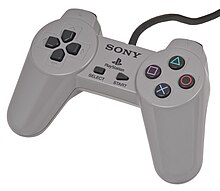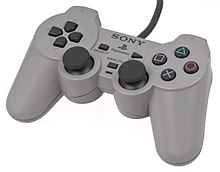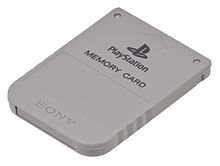User:Playstation Nintendo 3DS
Playstation Nintendo 3DS Is A Gameing Console,New Invented In 2006,And Published 2011 It Is A Controller With A Box.
How To Play Games[edit]
To Play Games You Need Emty Memory Cards,Than You Put Them In The Computer Drive,And Fill Them With Games In The Box You Insert Memory Cards Filled With Games.
Other Games Playstation[edit]
he PlayStation (プレイステーション, Purei Sutēshon, officially abbreviated as PS; unofficially referred to as the PSX[2] or PS1) is a 32-bit fifth-generation video game console first released by Sony Computer Entertainment in Japan on December 3, 1994.[3]
The PlayStation was the first of the PlayStation series of consoles and handheld game devices. Upgrades and variants include the Net Yaroze and the PSone, with the PlayStation 2 being the console's successor. The PlayStation was the first "computer entertainment platform" to ship 100 million units, which it had reached 9 years and 6 months after its initial launch.[4] Sony ceased production of the PlayStation on March 23, 2006, eleven years after it was released.[5]
Development[edit]

The first conceptions of the PlayStation date back to 1986. Nintendo had been attempting to work with disc-based technology since the Famicom, but the medium had problems. The Famicom Disk System's rewritable magnetic discs could be easily erased (thus leading to a lack of durability), and they lacked any sort of copy protection, thus were vulnerable to piracy. Consequently, when details of CD-ROM XA (which had neither of those problems) were released to the public, Nintendo was interested. Simultaneously developed by Sony and Philips, CD-ROM/XA was an extension of the CD-ROM format that combines compressed audio, visual, and computer data, allowing all to be accessed simultaneously. Nintendo approached Sony to develop a CD-ROM add-on, tentatively titled the "SNES-CD". A contract was signed, and work began. Nintendo's choice of Sony was due to a prior dealing: Ken Kutaragi, the person who would later be dubbed "The Father of the PlayStation", was the individual who had sold Nintendo on using the Sony SPC-700 processor for use as the eight-channel ADPCM sound set in the Super Famicom/SNES console through an impressive demonstration of the processor's capabilities.[6]
Sony also planned to develop a Super Famicom-compatible, Sony-branded console, but one which would be more of a home entertainment system playing both Super Nintendo cartridges and a new CD format which Sony would design. This was also to be the format used in SNES-CD discs, giving a large degree of control to Sony despite Nintendo's leading position in the video gaming market.

The SNES-CD was to be announced at the May 1991 Consumer Electronics Show (CES). However, when Nintendo's Hiroshi Yamauchi read the original 1988 contract between Sony and Nintendo, he realized that the earlier agreement essentially handed Sony complete control over any and all titles written on the SNES CD-ROM format. Yamauchi decided that the contract was totally unacceptable and he secretly canceled all plans for the joint Nintendo-Sony SNES CD attachment. Instead of announcing a partnership between Sony and Nintendo, at 9 a.m. the day of the CES, Nintendo chairman Howard Lincoln stepped onto the stage and revealed that Nintendo was now allied with Philips, and Nintendo was planning on abandoning all the previous work Nintendo and Sony had accomplished. Lincoln and Minoru Arakawa had, unbeknownst to Sony, flown to Philips headquarters in Europe and formed an alliance of a decidedly different nature—one that would give Nintendo total control over its licenses on Philips machines.
After the collapse of the joint project, Sony considered halting their research, but ultimately the company decided to use what they had developed so far and make it into a complete, stand-alone console. As a result, Nintendo filed a lawsuit claiming breach of contract and attempted, in US federal court, to obtain an injunction against the release of the PlayStation, on the grounds that Nintendo owned the name. The federal judge presiding over the case denied the injunction and, in October 1991, the first incarnation of the new PlayStation was revealed. However, it is theorized that only 200 or so of these machines were ever produced.[citation needed]

By the end of 1992, Sony and Nintendo reached a deal whereby the "Play Station" would still have a port for SNES games, but Nintendo would own the rights and receive the bulk of the profits from the games, and the SNES would continue to use the Sony-designed audio chip. However, Sony decided in early 1993 to begin reworking the "Play Station" concept to target a new generation of hardware and software. As part of this process the SNES cartridge port was dropped and the space between the names "Play Station" was removed becoming "PlayStation", thereby ending Nintendo's involvement with the project.
Launch[edit]
The PlayStation was launched in Japan on December 3, 1994, North America on September 9, 1995,[7] Europe on September 29, 1995,[8] and Oceania on November 15, 1995.[9] The launch price in the American market was US$299[7] and Sony enjoyed a very successful launch with titles of almost every genre, including Battle Arena Toshinden, Doom, Warhawk, Air Combat, Philosoma, and Ridge Racer. Almost all of Sony's and Namco's launch titles went on to spawn numerous sequels.
Functions[edit]
In addition to playing games, the PlayStation has the ability to read and play audio CDs. The CD player has the ability to shuffle the playback order, play the songs in a programmed order, and repeat one song or the entire disk. This function, as well as a memory card manager, can be accessed by starting the console either without inserting a game or keeping the CD tray open, thereby accessing a GUI for the PlayStation BIOS. The original PlayStation and PSone GUIs differ. The PlayStation GUI has a dark blue background and buttons that are designed like rainbow graffiti; the PSone has a blocked grey background with 2 icons; one for memory cards management, the other for CD player access (some versions of the original PlayStation have the blocked grey background, however, the memory card and CD player icons are different). If the CD lid is closed with a game inside at any time while at the menu, the game will immediately start.
Developer[edit]
Scott Armstrong Is A Wrestler,Inventer And Also A Referee,Armstrong Used To Make Games Better Known As Ezekiel Gabriel He Used To Defeat Heavy People Like Mark Henry,Big Show And Also The Great Khali,He Beated Brock Lesnar 4 Times.
- ^ "The Making Of: PlayStation". Edge. Future Publishing. 24 April 2009. p. 5. Retrieved 27 September 2009.
SCEA hated the name and wanted to change it to PSX, a contraction of the project's codename […] the US nevertheless went ahead with early trade promotion, calling it PSX,
- ^ PS-X (PlayStation Experimental) was an internal code name for the PlayStation during development.[1] The popular use of the "PSX" abbreviation outside Sony became a source of confusion when Sony introduced its PSX digital video recorder in 2003.
- ^ "Business Development/Japan". Sony Computer Entertainment Inc. Retrieved 2007-12-19.
- ^ "PlayStation 2 Breaks Record as the Fastest Computer Entertainment Platform to Reach Cumulative Shipment of 100 Million Units" (PDF) (Press release). Sony Computer Entertainment. 2005-11-30. Retrieved 2008-06-08.
- ^ Sinclair, Brendan (2006-03-24). "Sony stops making original PS". GameSpot. Retrieved 2009-08-20.
- ^ "Game Over", by David Scheff
- ^ a b Cite error: The named reference
developmentNAwas invoked but never defined (see the help page). - ^ Cite error: The named reference
developmentEUwas invoked but never defined (see the help page). - ^ Cite error: The named reference
auswas invoked but never defined (see the help page).
